|
Weather
- at least temperature and humidity - is all-important for the traditional matanšes
eivissencs (Ibicenco pig killing). The climate of Eivissa
is not suitable for the production of cured ham, so popular elsewhere in much
of Spain: traditional 'embutidos' (pig products) on the island are very specific
to its climate and water. The famous sobrassades and other types of local products
from the pig are cured specifically by low temperatures, certain humidity, and
the salt and spices in the mix. There is no smoke curing as on the Spanish mainland.
For these reasons there is an actual 'pig killing season' on Eivissa,
which officially starts on the day of San Martin (November 12th,
nicknamed 'mataporcs' - pig killing
day) and lasts through to the day of Las Candelas on the 2nd February.
But the mild winter temperatures here make it better ideally to kill the pig
before the end of January - "Mata
es porc pel gener, si vols que es
conservi bŔ" - 'Kill the pig by January if you want it to preserve
well'. Many phrases abound in Eivissenc
(the rare early sub-dialect spoken on the island) related to the timing of pig
fattening, killing, salting, etc: "Per Sant Tomas, agafa es porc p'es mas"; "Per Sant Marti, mata
es porc i enceta es vi";"Per Nadal, es porc en sal";"Qui
te porcs a la salera, bon any li espera";"Porcella i dona,
tot l'any es bona" and so on almost ad infinitum. But the cold - or
cool - weather is the essential element in the curing of the 'embutidos', if
the winter is too warm the products don't 'gel' well, they remain slightly softish
and cannot be stored for long before they go off.
Thus
extreme care is taken with these pig killings, not just in regard to the ambient
temperature but also, of course with the type of pig killed. We have already
spoken about the avoidance of killing a female pig within a certain time around
her menstruation. The ideal pig to kill is a castrated male pig. Ordinary male
pigs can, of course, be killed, but if castrated when young their meat and fat
produce sweeter tasting products. Sometimes the meat of uncastrated male pigs
can be almost inedible: it possesses what is sometimes called 'boar taint' in
English, particularly noticeable if one cooks such a pig's fat, when it can
sometimes give off a slightly foul, urine-like, sweaty odour. This is caused
by the presence in the fat of a chemical steroid called androstenone (the precursor
of the steroid androstenol), present in uncastrated pigs. In its precursor form
this steroid gives off a rank smell - not surprising, as it is also one of the
major chemical components of human underarm odour. Androstenone is produced
in the testes and released in the blood. Interestingly, one of its products,
androstenal, is stored in the pigs salivary glands. When a male pig becomes
sexually excited, he froths at the mouth, releasing this pheromone: if a nearby
female pig is in heat, she becomes immobilised by this chemical and permits
the male to mount her. Even more interesting is the use that related steroids
are put to in certain women's perfumes (such as Jovan's 'Andron' and 'Realm').
Although there is (as yet) no concrete evidence that androstenal works in the
same way in humans, one study of college age women in the US showed that women
wearing a necklace impregnated with the steroid found it much easier to strike
up conversations with men they did not know (? but shouldn't it be the other
way around?). Admittedly this is a slight digression here, but once one enters
the world of pigs anything can happen!
The
day of the matanša has arrived. The
casa pagesa (peasant house) is full
of the extended family, each ready for their allotted tasks. Some - who might
live far away - may have arrived the night before to be ready for an early start.
Nowadays many peasant families have relatives who may have not been brought
up in the traditional style, many working on the coast in tourism-related industries
or living in Vila (Ibiza town), and who, although taking part in the pig-killing
for the extended family, are thought not to like such activities any more. Many
peasant jokes exist regarding (particularly) female relatives arriving from
Vila to the original family homestead clad in fur coats, expensive jewellery,
high heels and with a scented handkerchief never far from their noses. The famous
Ibicenco play, 'Pera Bambu' ('Simple Peter') has such a matanša
scene, with the female relative from Vila swooning and fainting because of the
noise of the pig's squeals and the smell of the activities. Local audiences,
many of whom have actually seen similar incidences, always roar with laughter,
it is a scene now familiar to most Ibicencos.
Early
in the morning a group of men - usually four or five (but in the famous case
of the giant pig weighing 42 rovas - 420 kilos - a total of nine men) - will
go to the hut/corral where the fattened pig awaits. Deft rope throwing lassos
one of the pigs front legs and then the struggle is on to hook in the iron nose
hook if the pig is a big one. Normally a matanša
pig should weigh 20 rovas (200 kilos) or more, so they are rather hefty creatures.
The men will pull and push the pig to the banc de matar (pig killing board) where the matanšer (the pig killer) awaits. The matanšer is a respected specialist, it is an ancient and honoured
calling, and he directs and co-ordinates all the activities that day, almost
like a complex ballet. Ideally his wife is a matanšera (a female matanša
specialist), in which case he will co-ordinate the men's activities and she
will co-ordinate the activities of the assembled women. Matanšers will travel around the rural areas of the island during
the pig killing season: their work is becoming more exhausting now though, as
their numbers are diminishing and there is a lack of 'new recruits'. One sad
day in the future there may be no traditional matanšers left, then many pagŔs
(peasant) families may be forced to take their pigs to the modern butchers if
none in their families can step into the gap.
Traditionally,
the men and women would work in nearby but separate areas. The men work on cutting
up the pig and the women (even
today only women that are not having their monthly menstruation) deal with preparing
the 'embutidos' from the meats passed to them by the men. An exception is the
pig's blood. Once the pig has been placed, struggling, on the banc
de matar, the matanšer deftly kills it with a swift stab of the special pig-killing
knife into the jugular vein. A special woman with a bowl waits by the side of
the matanšer to fill up the bowl with
this first large spurt of blood from the jugular. Once this bowl is full she
immediately retires to a corner of the women's area, where she will stir the
blood, whilst still warm and whilst it cools, with her hand to prevent it coagulating.
This blood is that used to make the botifarras, the large 'embutidos' of blood
that are then cooked for hours in boiling water. Further blood taken from the
pig is drained into a bowl whose bottom has been covered with salt: this blood
is then fried for the matanša lunch.
This latter is all done in the women's area, where other women are also preparing
the special rice and other foods for the lunch (which on Eivissa
usually takes place from around 3pm onwards).
Once
the pig has been killed, its hair is singed off with burning fragrant brands
(see previous articles), but nowadays this is often done with bottled gas flame.
The skin is then scraped and cleaned with a special scrubbing stone - pedre tosque - ideally of pumice (but nowadays sometimes of a small
square piece of wood with beer bottle tops nailed 'bottom out' to the wood)
and hot water. A final skin cleansing, almost like a close shave, can be done
with a sharp knife and hot water. The hoof extremities are then pulled out and
thrown away. After all this has been done the pig can be weighed on scales if
there are any around. The pig can then be shifted to a larger and wider wooden
bench to be cut up. Placed belly down on the table, its ankles are cut and the
legs bent underneath it. The matanšer
then cuts the head off, starting from the nape of the neck down through the
neck column. Shifting to one side of the bench he then cuts down each side of
the spinal column and cuts and lifts out the large layers of fat that cover
both sides of the back. These thick layers of fat, called sa xulla, are a great delicacy and can eventually be sliced or cut
to produce es corters de xulla gorda,
more manipulable in size, great as gifts or easy to hang by iron hooks for curing.
The lean meat covering the ribs is then taken off and now the matanšer
takes out the os de s'espinada and
ses espatles, the spine and shoulder blades. Step by step each part
of the pig is taken out for use and almost nothing is wasted. Sa
freixura blanca, the heart and lungs are carefully taken out to be eventually
mixed in as part of the content of the botifarras. As much as possible of the
pig is used: in a pig of, say, 20 rovas (200 kilos), only 5 rovas (50 kilos)
would not be used. Next week we will see how that 15 rovas would be used.
With
thanks to Antonio Bonet Tur and Ana of C'an Joannot, Bartomeu i Annabel de S'hort
den Bartomeu de sa Plana, Josep de Sa Torra, and for the work of MariÓ Torres
Torres - and with thanks to quite a few pigs who are sadly no longer with us.
| 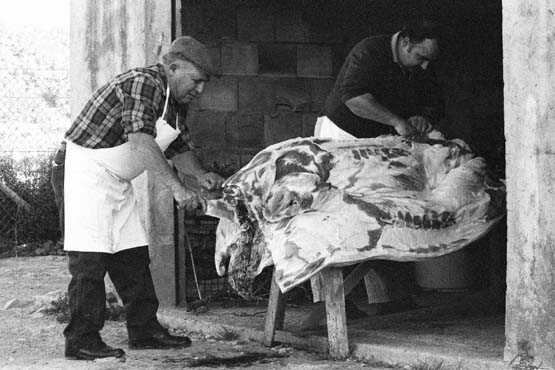
|
| 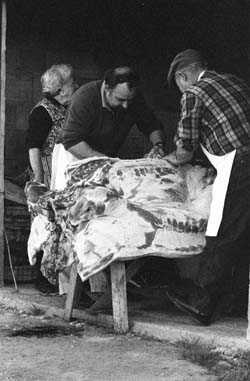
|
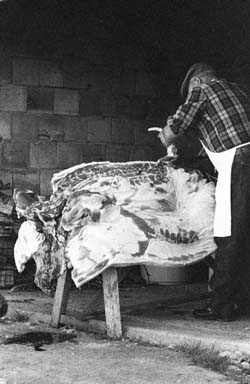
|
| 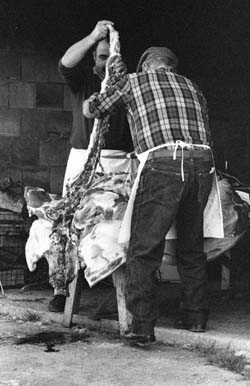
|
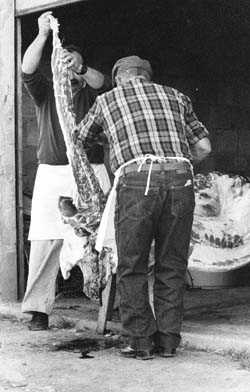
|
| 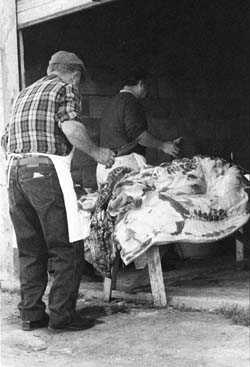
|
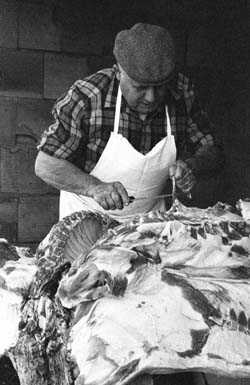
|
| All pictures
© Gary Hardy (January 1991) |
|